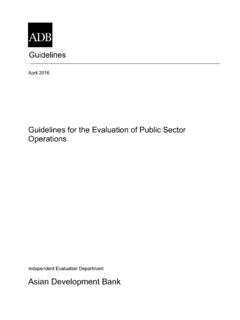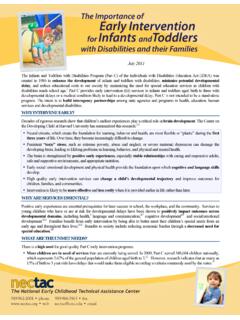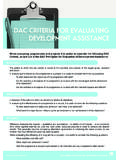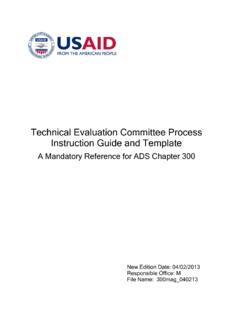Transcription of Evaluation Reporting: A Guide to Help Ensure Use of ...
1 Evaluation Reporting: A Guide to Help Ensure Use of Evaluation Findings Evaluation Guide National Center for Chronic Disease Prevention and Health Promotion Division for Heart Disease and Stroke Prevention Acknowledgments This Guide was developed by the Centers for Disease Control and Prevention, Division for Heart Disease and Stroke Prevention, Applied Research and Evaluation Branch. The authors (Alberta Mirambeau, Joanna Elmi, Jan Losby, and Derrick Gervin) wish to thank reviewers in the Division for Heart Disease and Stroke Prevention (Marla Vaughan, Diane Dunet, and Kristy Mugavero), and we wish to extend special thanks to external reviewers who provided valuable suggestions on an earlier version of this document Patricia Affleck and Sylvia Kuo, Rhode Island Department of Health Matt Daubresse, Maryland Department of Health and Mental Hygiene Phyllis Dower, Connecticut Department of Public Health Suggested Citation Centers for Disease Control and Prevention.
2 Evaluation Reporting: A Guide to Help Ensure Use of Evaluation Findings. Atlanta, GA: US Dept of Health and Human Services; 2013. The findings and conclusions in this report are those of the authors and do not necessarily represent the views of the Centers for Disease Control and Prevention (CDC). Web site addresses of nonfederal organizations are provided solely as a service to our readers. Provision of an address does not constitute an endorsement by the Centers for Disease Control and Prevention (CDC) or the federal government, and none should be inferred. CDC is not responsible for the content of other organizations Web pages. PURPOSE OF THE Evaluation GUIDES CDC s Division for Heart Disease and Stroke Prevention (DHDSP) Evaluation guides are a series of Evaluation technical assistance tools developed for use by CDC-funded programs.
3 State health departments, tribal organizations, communities, and partners working in a variety of public health areas may also find these tools helpful. The guides clarify approaches to and methods of Evaluation , provide examples specific to the scope and purpose of DHDSP programs, and identify resources for additional reading. The guides are also intended to aid in skill building on a wide range of general Evaluation topics while recognizing that funded programs differ widely in their experience with, and resources for, program* Evaluation . This Evaluation technical assistance tool is best used in conjunction with other DHDSP Program Evaluation Guides in the series uWriting SMART Objectives uDeveloping and Using a Logic Model uDeveloping an Evaluation Plan uFundamentals of Evaluating Partnerships uUsing Indicators for Program Planning and Evaluation *In this Guide , the term program refers to any intervention, practice, strategy, or environmental approach that promotes public health goals.
4 Evaluation REPORTING: A Guide TO HELP Ensure USE OF Evaluation FINDINGS | 1 INTRODUCTION Importance of Evaluation Reporting to Ensure Use There are various aspects of Evaluation reporting that can affect how information is used. Stakeholder needs, the Evaluation purpose, and target audience should be considered when communicating results. Evaluation reporting should not only identify what, when, how, and to what extent information should be shared but take into account how information might be received and used. In a 2006 survey of American Evaluation Association members, 68% self-reported that their Evaluation results were not Findings such as this suggest a greater need for Evaluation results to make it off the bookshelf and into the hands of intended audiences.
5 Similarly in the CDC Framework for Program Evaluation , 2 the utility Evaluation standard charges evaluators to carry out evaluations that lead to actionable findings for intended users. This commitment to conducting evaluations that improve the lives of participants serves as the inspiration for this Guide . This Guide is one in a series of Program Evaluation Guides developed by DHDSP to assist in evaluating heart disease and stroke prevention activities. This Guide focuses on ensuring Evaluation use through Evaluation reporting and addresses the following topics uKey considerations for effectively reporting Evaluation findings uEssential elements for Evaluation reporting uImportance of dissemination uTools and resources While this Guide offers suggestions and resources for Evaluation reporting, always refer to the reporting requirements set forth by your funding source to Ensure full compliance in reporting Evaluation findings.
6 Who Might Use This Guide uProgram managers can collaborate with evaluators to identify appropriate Evaluation products and processes. uEvaluators and epidemiologists can use the Guide to help communicate findings and outcomes. uOther stakeholders can use this Guide to help with dissemination efforts. 2 | Evaluation REPORTING: A Guide TO HELP Ensure USE OF Evaluation FINDINGS the Evaluation and findings will be used uReassess what the users of the Evaluation want to learn KEY CONSIDERATIONS FOR EFFECTIVELY REPORTING Evaluation FINDINGS In determining how to report your Evaluation findings, there are a few key considerations to Guide you through the Evaluation report development process.
7 Incorporating these ideas increases the likelihood that the intended users will take action or influence someone or something based on the findings presented in your Evaluation report. The following three areas are reinforced throughout the Guide but are not intended to be sequential in nature uEngage stakeholders uRevisit the purpose of your Evaluation uDefine your target audience Engage Stakeholders Most program Evaluation frameworks, including the CDC Framework for Program Evaluation , 2 promote the engagement of stakeholders as an important component of the Evaluation process. Stakeholders individuals who are invested in the program or potentially affected by the Evaluation can play a key role by offering input throughout the Evaluation process to Ensure effective and useful reporting of Evaluation results.
8 Strategically encouraging input and participation from this group at critical points along the way can increase the likelihood that Evaluation findings will be used. There are several opportunities for engagement uDuring the planning phase, stakeholders can help determine the intended use of the Evaluation findings, identify potential primary users of findings, and help develop a reporting and dissemination plan uOnce data have been collected, stakeholders can review interim findings, interpret data, help prepare findings, and assist in developing potential recommendations uStakeholders can also play a key role when developing the Evaluation report by defining the audience, identifying any new potential uses of the information, and ensuring report findings meet the Evaluation purpose To maximize stakeholder involvement and expertise.
9 Consider ways to keep the lines of communication open from the initial stages of planning through reporting and dissemination. Remember, stakeholder needs should be prioritized, recognizing that the Evaluation may not be able to address everyone s interests. QUICK TIP To re-engage stakeholders in reviewing the Evaluation purpose statement uRevisit how Evaluation REPORTING: A Guide TO HELP Ensure USE OF Evaluation FINDINGS | 3 4 | Evaluation REPORTING: A Guide TO HELP Ensure USE OF Evaluation FINDINGS Revisit the Evaluation Purpose It is always helpful for an Evaluation to have a clearly defined purpose statement that articulates the reason for and intended use of the findings.
10 At every phase of the Evaluation , including development of the report, revisit the agreed upon intent of the Evaluation to see whether the purpose continues to capture new program developments and emerging needs or priorities. You may need to revisit the purpose if there are any changes in uStakeholders uIntended users of the Evaluation report uPriorities of the program or Evaluation uInformation needs of the Evaluation uProgrammatic context uOrganizational context The purpose determines how the Evaluation report and findings are used, who the users are, and the most appropriate type of reporting. There may be multiple purposes for conducting an Evaluation . The following highlighted area summarizes some common purposes for conducting public health evaluations.















